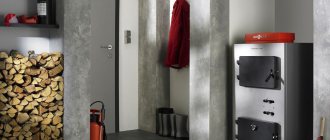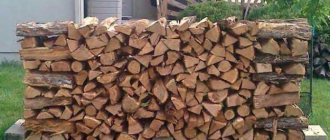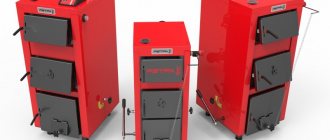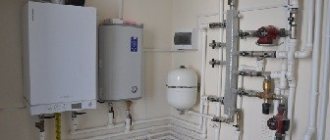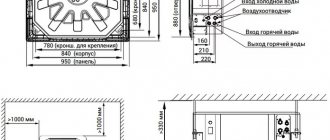
Heating stove for summer cottages Today, many are trying to escape from civilization, settle somewhere outside the city and enjoy nature. Fresh air, clear skies are good, but modern man is used to amenities and wants them to surround him everywhere. When purchasing a country house, many try to immediately find out if communications have been carried out to it. Well, when a gas main passes nearby, then the heating problem is solved by itself. And what if there is none at all, how to live in the cold season? Alternative heat sources help to solve this problem. You can take advantage of wood and electricity heating in your country house.
In order not to miscalculate and not go broke, you need to know which method is more effective and affordable. To do this, simply compare them.
Design features and principle of operation
Wood-fired boilers can be used to heat a house, to heat cold water, and at the same time, both for heating and for obtaining hot water. Since a heating boiler using wood as fuel is exposed to open fire and corrosive condensate, special grades of steel or cast iron must be used for the manufacture of its firebox and water jacket.


The device and principle of operation of a solid fuel hot water boiler
Heating with wood in a private house can be created using the following types of heating equipment:
- pyrolysis heating devices;
- long burning boilers;
The wood-fired pyrolysis heating device consists of two combustion chambers. In one of them, the primary combustion of wood is carried out, in which flue gases are released. In the second chamber, these flue gases are completely burned, releasing additional heat. This heat generation technology can significantly reduce the consumption of fuel materials.


The choice in favor of solid fuel boilers is not accidental
A long-burning hot water boiler has a high efficiency. It is able to provide uniform heating of the coolant and low fuel consumption with high heat transfer rates. How long will one tab of firewood burn? As a rule, one bookmark of firewood is enough to operate a hot water boiler for 24-48 hours.
Wood-fired hot water heating equipment is a closed vessel. The wood loaded into the firebox burns out and releases thermal energy, which heats up the coolant in the water heating circuit. Further, water from the heat exchanger enters the heating system of the house under pressure, heating all its rooms.
Purpose
The hot water boiler is used to heat small buildings, cottages and town houses. Usually, such units are used in the absence of a central heating system or in a situation where it is inexpedient to build a boiler room. In addition to heating, they are used in the hot water supply system.
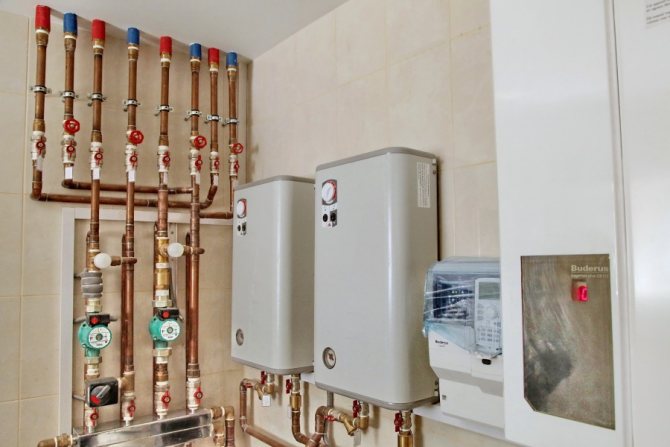

A hot water boiler is a device for heating water under pressure, i.e. without the possibility of its boiling.


Using electric boilers


Installation diagram of an electric boiler in the heating system.
In order to heat all housing with electricity, a boiler is installed that heats the water to a certain temperature, and then it circulates through the heating system by means of a coolant. Many believe that the installation and use of such boilers is an uneconomical option for a private mansion.
In this case, gas, in comparison with electricity, is much more practical, but this is if there is an accessibility to the gas main. Although the installation of gas equipment and maintenance of gas boilers pay off for a very long time.
The main advantages of using electric boilers:
- ease of use of equipment;
- fast heating of the house;
- temperature control;
- installation of equipment at any time of the year.
The principle of operation of an electric boiler practically does not differ from a gas heating system. The difference is that water is heated by heating elements, not gas. In this case, heat throughout the living room occurs in the same way as with gas heating, that is, in the pipeline with the help of a heat carrier.
How to choose a wood-fired boiler for a private house
When choosing a heating boiler for a private house, several points are taken into account regarding design features and performance:
- Heated area - approximate performance calculations are carried out according to the formula 1 kW = 10 m². When connecting the second circuit for hot water supply, add another 15-20% to the result obtained.
- Types of heating boilers - as already noted, there are classic units, as well as those that use the principle of pyrolysis combustion. The latter are considered the most economical wood-fired boilers for individual heating of private country households. The first ones are 3-4 times cheaper.
- Heat exchanger type - there are two types. Differs in the type of materials used and construction. Steel boilers are cheaper, but they serve on average 10-15 years less. The units are not afraid of shock and mechanical damage, easy to repair and maintain. Cast iron boilers, on average, serve about 35 years, have the best thermal performance. They are afraid of mechanical damage. Repair will require replacement of an entire section. Another disadvantage of cast iron is the large weight of the boiler. The pyrolysis unit, which has two combustion chambers, easily reaches a mass of 5 centners.
- Features of the design of the combustion chamber - manufacturers produce boilers with side loading of firewood. The design is used in most units, both classic and pyrolysis types. Top-loading boilers deserve special attention. This design is used in gas generating units. The main advantage of the solution is the possibility of pre-drying the wood, which increases the heating efficiency.
- The presence of additional functions - automation, the presence of a backup power source, a built-in storage boiler, a remote control system - all this increases the comfort of operation and is provided as an optional extra.
In addition to the technical parameters, you will need to decide on the brand of the wood-burning boiler and select a heat generator of a suitable price category.
Which boiler to choose
If funds permit, it is better to supply a German or Czech-made wood-burning boiler. Somewhat worse in terms of production characteristics, Polish and domestic units. Among foreign and domestic manufacturing companies, the leaders are:
- German wood-fired boilers - presented by Buderus. Viessmann. Lopper. All equipment has a high degree of safety and reliability, and a long service life. The disadvantage of the models is whimsicality to the quality and type of firewood, high cost.
- Czech-made wood-fired boilers - the products of OPOR companies deserve attention. Viadrus. and ATMOS. In terms of quality and automation, the models are in no way inferior to their German counterparts, but have an average cost of 10% less.
- Russian-made boilers - TT units are produced by almost every manufacturer of heating equipment.The boilers are adapted to domestic conditions, unpretentious to the quality of the fuel and the heat carrier used. The most popular are the products of the following factories: ZOTA. Teplodar.
- Polish wood-burning boilers - several dozen modifications are offered on the domestic market. Models are in demand: Defro, SAS, DREWMET, ORLAN. The range includes both conventional wood-burning heat generators and pyrolysis combustion boilers.
Most manufacturers, in addition to classic heating boilers operating exclusively on wood, offer universal or multi-fuel heat generators.
Cost of wood-fired boilers for country houses
Several factors affect the cost of the unit:
- Heat exchanger type - a cast iron boiler will cost 1.5-2 times more than a steel analogue.
- Manufacturer.
- The principle of operation - the cost of a wood-burning gas-fired boiler of a domestic manufacturer will cost 35-40 thousand rubles. and the price of a boiler of classical design will drop to about 20 thousand rubles.
- Additional equipment.
Registration of documents for commissioning the boiler, subject to their registration with Rostekhnadzor, is not required.
Making a wood boiler with your own hands
Is it difficult to make a wood-burning boiler for your home with your own hands? The main condition for this design is the thickness and grade of the steel used. In factory models, the outer casing is made of heat-resistant steel with a thickness of 1.5 mm. For a heat exchanger, these parameters should be larger - from 2 mm.
The best option is to create a welded structure that will be similar in shape to the factory models. However, if you calculate the labor intensity of the work and the cost of materials, the difference between buying and making it yourself will be small. Therefore, as an alternative to wood-burning stoves for a home with water heating, simple steel barrels are often used. The main condition is their wall thickness - from 1.5 mm.
For manufacturing, you need a capacity of about 200 liters. It is cut along and a partition is installed inside. Its length should be less than the length of the barrel. This is necessary for the installation of grates.
Then holes are cut on the front side for mounting the doors. They should be selected in advance so as not to be mistaken with the size. To remove carbon monoxide, a chimney is cut into the back of the structure. Its diameter can be from 50 to 100mm.
However, judging by the reviews about such a wood-burning heating boiler, the following disadvantages can be noted:
- Low efficiency rate;
- Heating of the case, which can lead to burns when touched;
- Short service life.
Similar designs are used to heat small utility rooms - a garage, warehouse, etc. For the home, it is best to purchase a factory quality model. It will match modern wood-fired heating schemes.
Before making a homemade wood-burning boiler for the heating system, it is necessary to calculate the optimal dimensions of the firebox.
Wood heating schemes at home
The key point in the design of wood heating is the choice of the scheme. It depends on it - whether a wood-burning boiler will be installed with your own hands or whether a stove or fireplace will perform its functions. To determine the best option, all possible factors must be taken into account.
First of all, the area of the building and the number of rooms are taken into account. Most often, wood-burning heating stoves for summer cottages are installed if there are a maximum of two rooms. In this case, it is not necessary to make a water heating system.
Let's consider the main factors influencing the choice of the type of heating:
- Water... Consists of a boiler (stove, fireplace) connected to a pipeline. The transfer of heat energy occurs due to installed radiators. The best option for a house with an area of 80 m²;
- Stove... Wood-burning stoves are used to heat the air in the room. They are characterized by low efficiency, small heating area. However, their arrangement requires the least effort. The exception is fireclay brick structures. This type is used for heating houses with an area of less than 60 m²;
- Fireplace... Analogue to stove heat supply. The difference is pumped up in the size of the combustion chamber - at the fireplace it is much larger. In addition, heating a private house with a wood boiler sometimes implies the presence of a hob in the design.
As you can see, the choice of option directly depends on the area of the house. It should be borne in mind that the wood heating scheme can be upgraded. It is enough to install a heat exchanger in the furnace to make it possible to make a full-fledged water heat supply.
But the most common option is to install a wood-fired boiler to heat your home. It is much more practical and easier to use than a fireplace or stove.
For the normal operation of wood heating of a country house, it is necessary to think over the chimney system in advance. The optimal pipe diameter and height are taken into account.
System inertia
Another drawback of a solid fuel boiler is hidden in the cyclical nature of its operation and the inability to independently replenish fuel reserves. Because of this, either a high heat capacity of the house structure itself is required, or a deaf insulation, close to a passive house, or a way to store a supply of heat for the period of cooling of the system.
Since the volume of the heat exchanger itself in the boiler is small, the displacement of the system can be raised mainly by increasing the diameter of the pipes. Another alternative of this kind is the installation of a heat accumulator. With the right approach, it is possible to realize the accumulation of heat only after heating the main system, which will help speed up the heating of the house and solve the problem with condensation.
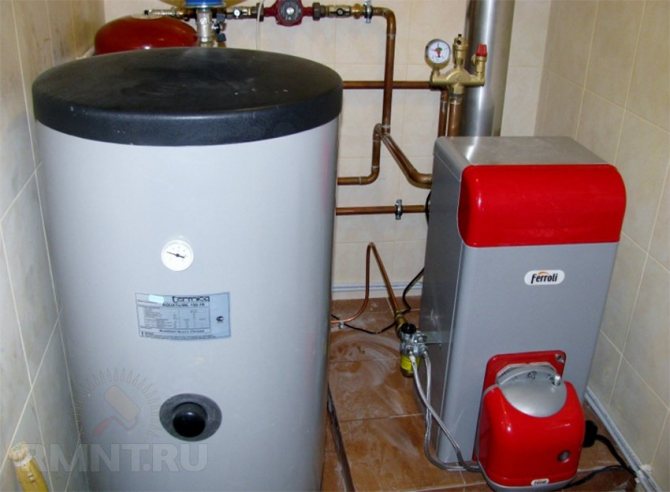

Underfloor heating systems have their own high inertia, which grows with the thickness of the accumulating screed. With an underfloor thermal cutoff, this can be a truly long-term source of heat. With a sufficiently thick layer, even the use of water of a higher temperature will not cause discomfort and a thermal zebra, but together with the inertia of the system, the time it takes to reach the regime increases. On the other hand, connecting a warm floor to a wood-burning boiler requires a rather complex piping, which excludes overheating of both the boiler and the pipes in the floor.
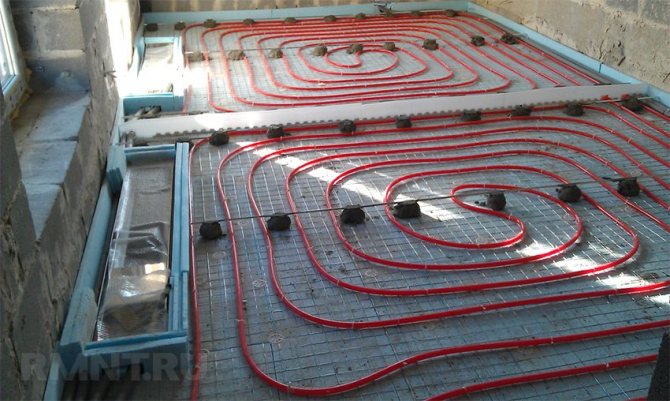

Equipment power
Ultimately, for the boiler, it is not so much the details of its internal structure that are important as the main performance indicators that have been achieved using a number of engineering innovations. The most important and defining parameter of the boiler is its rated instantaneous power. The heat capacity for different types of fuel is different, as well as for different types of firewood, the manufacturer cannot accurately predict it and calculate the rated power in a particular operating mode.
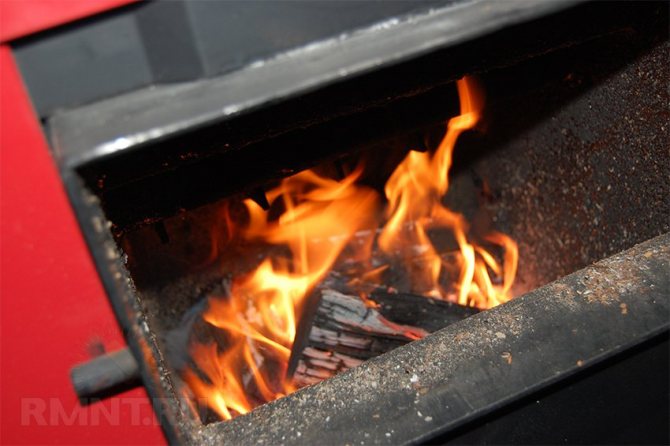

Determination of power occurs according to two indicators. By the volume of the firebox, one can judge the weight of the bookmark. On average, it is believed that for every kilowatt of power of a wood-burning boiler there is 2.5-3 liters of the volume of the combustion chamber. Having received the instantaneous value of the power released during combustion, it is possible to predict how much of it can be absorbed by the heat exchanger at different operating temperatures. Usually, absorption is deliberately made higher than the calculated heat release in combustion conditions close to optimal, but this approach is fraught with trouble.
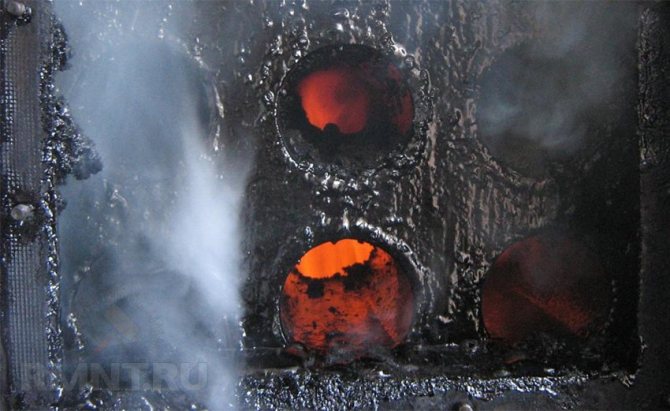

The fact is that all wood-burning boilers suffer from a common disease - the formation of tar due to the high moisture content of the burned wood. Condensation only occurs when the temperature difference is high enough. So, the formation of build-ups on the economizer or secondary heat exchanger can stop when the heat carrier heats up to 40-45 ºС.The bottom line is that if you load the boiler by half, its power will not be enough for normal heating of the walls and heat exchangers, because of which the equipment will simply "flow".
Specifications
Most of the wood-fired hot water boilers on the market today have the following performance characteristics:
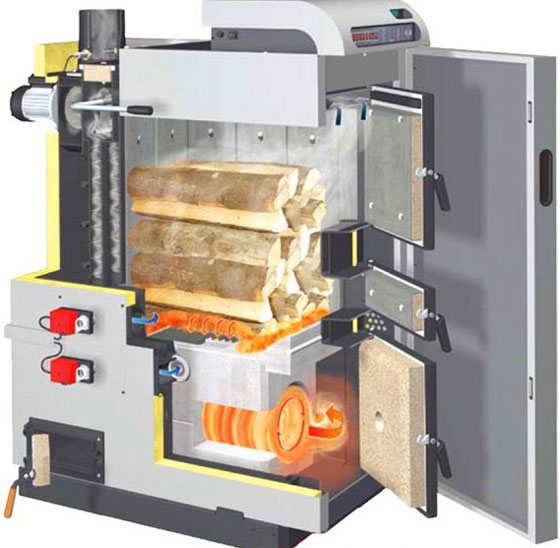

The principle of operation of the upper combustion boiler
- Power. This indicator depends on the volume of the heat exchanger, the volume of the combustion chamber and the material from which the walls of the furnace are made. Also, the power consumption of the boiler is directly influenced by the consumption of fuel material. The more firewood is loaded, the more heat energy will be released during combustion. How many kilowatts do you need to heat a private house? To find out what power is required to heat a particular room, you need to use the following ratio: to heat 10 m² of a room, 1 kW of thermal energy is required.
- Efficiency. To calculate the efficiency of the device, you need to know the circulation rate of the coolant, the amount of heat given off by the wood during combustion, and also take into account the way the fuel is burned. The efficiency of heating equipment for long-term burning and pyrolysis systems can reach up to 85-95%.
- Heat carrier. Water is used as a heat carrier in wood-fired heating systems. Alternatively, use of any anti-freeze liquids is allowed.
- Purpose. In winter, the boiler can be used both for heating and for heating water. In summer, the main purpose of a wood-fired boiler is to provide hot water.
Advantages and disadvantages
Heating with wood is characterized by a number of indisputable advantages, the main of which are the following indicators:
- Low weight of heating equipment. For wood-fired boilers, unlike their counterparts operating on other types of fuel, there are no strict requirements regarding their design and installation location. Therefore, a self-made boiler can be installed in any part of a country house, although the allocation of a separate room for the furnace will be the most correct solution.
- Automatic control system. The minimum number of components of the ATS of an industrial boiler allows not only to efficiently carry out the consumption of fuel material, but also reduces the likelihood of failure in operation in the event of failure of one of the control devices.
- Versatility. In wood-fired heating boilers, not only wood can be used as fuel, but also any other type of solid fuel.
- Long service life. A wood-burning boiler will serve its owner for more than one winter. How many years will an industrial-made boiler last? Manufacturers of this type of heating equipment guarantee at least 15 years of trouble-free operation.
- Ease of maintenance. In the course of performing work related to the maintenance of the heating boiler in a private house, it is only necessary to clean the ash pan and chimney only once a year.
- Acceptable price. How much do you need to pay when buying a boiler? The price of each specific model depends on the number of options present in this equipment. It can be noted with complete confidence that every owner of a private house can purchase a wood-fired heating boiler without serious damage to the family budget.
Unfortunately, wood-fired hot water boilers are not without certain disadvantages. These disadvantages apply only to wood-fired boilers made by handicraft. One of them is that it is impossible to automate the control process in a home-made wood-burning boiler, so the owner of such equipment needs to manually load fuel into the combustion chamber.
The second drawback is the "gluttony" of a self-made water boiler. In order for the operation of this equipment in winter to provide comfortable living conditions, it is necessary to create a large supply of firewood. How much firewood do you need to last the whole winter? Fuel consumption for each specific case is individual. The amount of stored firewood depends on the power of the heating device and the area of the heated premises of a private house.
Modern methods of heating a summer house with wood
If you have the necessary funds, often use a dacha and do not want to work all weekends as a stoker, then you can consider some other ways to heat a dacha with wood.
Bulleryan oven. A number of heating devices are manufactured under this name, the principle of operation of which is that air enters the bunker, where firewood slowly smolders. This results in a high CO content producer gas. This gas burns almost completely with a uniform and long-lasting heat release. And the pipes built into the structure provide quick removal of the heated air and heating the next portion according to the convection principle.
http:
Small in size, compact, bulleryans can heat a room with a volume of up to 100 cubic meters, if there are no obstacles to the movement of air. The efficiency of these devices reaches 80%, the duration of combustion of a one-time fuel load is 9-12 hours. In addition, they have a fast heating mode, which, according to user reviews, allows you to raise the room temperature to + 18⁰C in 4 hours at -25⁰ outside. These stoves are not suitable for heating summer cottages with several isolated rooms, the firewood must be well dried, and their operation also requires strict adherence to certain safety rules.
Wood-fired boiler. If your summer cottage has a complex architecture and consists of several rooms and floors, then you cannot do without a water heating system, consisting of a boiler, pipes and radiators. Solid fuel boilers are available in various models and cost, their efficiency is not very high (60-65%), but higher than that of the stove (up to 40%). Fuel loading and boiler cleaning is carried out approximately every 6-8 hours. And if you replace the water in the heating system with antifreeze, then the problem of pipe rupture is solved during an extreme cold snap.
Pellet pyrolysis boiler. If you still dream of an automated heating system for your summer cottage, and an electric or gas boiler cannot be installed for some reason, consider the option that is very popular in Europe, due to the ability to automate the process and the cheapness of the fuel used.
http:
A pyrolysis boiler is a product of modern technologies, operating on the principle of a gas generator, and has an efficiency of up to 90%. And pellets are obtained as a result of processing waste from the woodworking industry into compact pellets. The cost of pellets is much lower than the cost of liquid or gaseous fuel, moreover, it is growing all the time. In addition, this is an environmentally friendly raw material, it burns almost completely, without emitting substances harmful to health. The process of pellet filling, ignition, and waste collection is automated, and the boiler operation time without human intervention is determined only by the capacity of the pellet hopper, and then it comes down to adding fuel pellets to the hopper. Heating with such a boiler has only one drawback - the very high cost of the equipment itself and the need for uninterrupted power supply for the built-in fan to work.
davaistroy.ru
Other types of heating a country house or summer cottage
Using a heat pump
With such a new alternative as a heat pump, space heating without gas and firewood has become more affordable for everyone.This method is really the best type of heating a country house or summer cottage. The installation generates heat from natural resources: land, sea, lakes and even air. But the heat pump is not very popular among consumers due to the high cost of equipment and installation work.
The use of liquid fuel units
The main fuel for liquid fuel boilers is diesel fuel, and the equipment used to heat the room is called diesel. Instead of diesel fuel, sometimes kerosene or rapeseed oil is used. But due to their high efficiency, oil boilers are rarely installed in private houses, but they are very effective for heating large buildings.
Using solar collectors
Recently, owners of private houses have increasingly begun to use solar collectors, in which solar energy is converted into heat. It is most practical to install such collectors on the roof of the house so that it is possible to receive as much solar energy as possible. The main disadvantage of such an installation is the direct dependence on the weather and the number of sunny days.
Today, effective types of heating used to heat a country house or summer cottage are an electric heating installation and solid fuel boilers. It is these two types of fuel that are excellent substitutes for gas and firewood, they are considered the most affordable for consumers, both in the installation of equipment and in the connection of the heating system. The rest of the options, giving heating and heat to the dwelling, are used directly as an additional method to existing installations.
Heating a summer house with wood: advantages
Of course, this option for heating a room is considered one of the simplest, however, it has a number of advantages:
- Wood-fired heat generators allow you to quickly heat a room.
- This type works without batteries and piping systems, which eliminates the need to install them.
- Small ovens are ideal for small spaces and provide an extra hob.
- A wood-fired heating boiler is considered one of the most environmentally friendly types of units.
Moreover, stoves of this kind provide an atmosphere of warmth and comfort, and the crackling of wood in the hearth creates an unforgettable impression of harmony and love. In addition, wood heating of a country house also has a positive effect on the health of its inhabitants, due to the high environmental friendliness of wood as a type of fuel.
In addition, it is beneficial in terms of material costs. In addition, if there is a small forest next to the house, the question of how to heat the house with firewood disappears by itself. Moreover, the whole installation looks very nice both with your own eyes and in the photo and video.
Varieties
The consumer has a choice among several solutions, each of which has its own pros and cons. Heating systems of a residential building in any case must be reliable, and also meet the requirements of thermal power (living space, intensity of operation, length of the cold season in the region, etc.).
Classic boiler
This design is the most simple and straightforward of all that exist on the market today.
Features:
- similar to an ordinary stove - equipped with a firebox, chimney and ash pan;
- operation does not require complex knowledge;
- runs on fuel with low efficiency;
- consumes a large amount of firewood.
If you plan to install the media wiring at your facility, classic boilers will not work for you.
Pyrolysis boiler
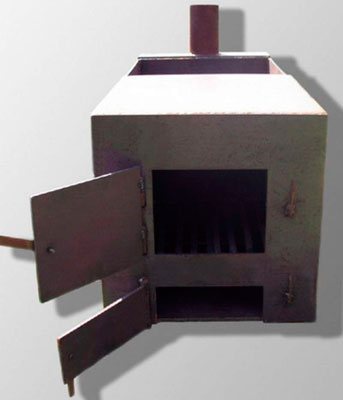

The efficiency of such heating is much higher than in the previous case.
Design features:
- relative novelty in the market (therefore, reviews are still few in number and it is premature to draw global conclusions);
- it is possible to generate high efficiency;
- with high efficiency, significant savings in consumable fuel are achieved;
- the exhaust gases in the combustion process move into the pipe;
- from the pipe, pyrolysis gases transfer their temperature to the heat exchanger;
- judging by the above, I would like to call this design ideal. However, it has a significant drawback - a strict selection of fuel.
Long burning boilers


According to experts, it is preferable for heating a private house
Features:
- such boilers with a water circuit are capable of operating for long hours on one wood-burning tab (the figure of 3-5 days speaks for itself, and the kind feedback from grateful users only strengthens the reputation of these products);
- such long-burning furnaces can operate on different types of fuel (and are easily reconstructed from one to another).
Alas, getting one for little money is simply unrealistic. Comfortable pleasure costs a lot of money and, as they say, will cost a pretty penny.
Safety requirements
It should be remembered that boilers with a water circuit require attention from a safety point of view. It is not only about the risks of ignition, but also about full-fledged air-gas handling.
Fire hazard.


- The most important are the following points:
- availability of free space for storing fuel - firewood cannot be stored directly at the stove, since the risk of ignition increases;
- it is necessary to provide exhaust ventilation in the room, especially if you have purchased a high-power boiler to heat the house;
Without sufficient ventilation, the unit will not cope with the amount of gases emitted during combustion. But among them there is carbon monoxide.
- it is strictly necessary to ensure the remoteness of the boiler from the walls and from the ceiling at a distance of at least 1 m;
- the size of the room must be at least 8 sq. meters;
- the base must be non-flammable. For this purpose, the site is being concreted. Another option is to cover an existing pedestal with tiles or iron, if it is, for example, wooden.
Chimney
The safety of the whole house and residents also depends on:
chimney material - stainless steel. Only this material will protect the structure from the deposition of oily soot and resinous substances. Stainless steel has a high coefficient of sliding, that is, microparticles are repelled and not "stick";
Simple iron pipes are very difficult to clean due to the abundance of resinous and soot deposits.
- make sure that the chimney goes through the wall of the house at a certain angle, and ideally, you need to make a hole in the roof. This measure will provide a full-fledged exit of combustion products to the outside;
- Be sure to place the upper edge of the pipe about 1 m above the ridge of the roof. Otherwise, there will be insufficient traction.
Features of heating with wood
Heating a room with wood has a number of features. In particular, when organizing it, it is necessary to observe a number of guidelines and fire regulations. In addition, during the operation of boilers, the safety instructions must be strictly observed.
In addition, you need to make a supply of firewood in advance so as not to do this in the winter. Since a fairly large amount of firewood is needed, it is necessary to prepare a place for storing them so that the firewood does not become damp. If it is not possible to put firewood in the room, then you need to make at least a canopy in the yard of the cottage.
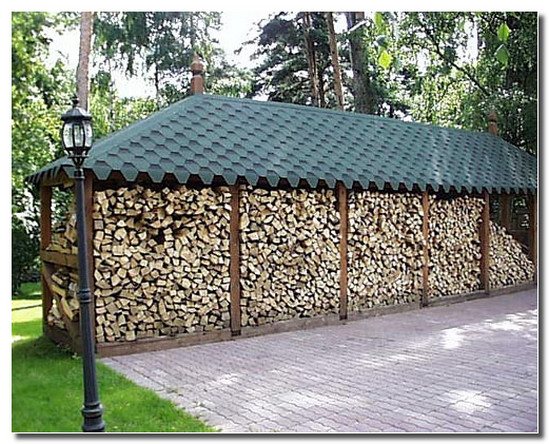

In the photo - a canopy for storing firewood
As for the amount of firewood needed to heat a house in winter, it depends on many factors, the main ones are as follows:
| Climate conditions. | The more severe the winter, the more active heating will be required. |
| The material from which the house is built and the thickness of the walls. | The lower the thermal conductivity of the walls, the warmer the house will be, and accordingly, less firewood will be needed. |
| The area of the premises. | Large rooms require more firewood to heat up. |
Advice! To ensure the maximum efficiency of wood heating, it is necessary to insulate the house, as well as to eliminate gaps in windows and doors.
Automation and piping of wood-fired boilers
As already mentioned, the boiler power can be adjusted only by changing the amount of supplied oxygen. This system works most efficiently and accurately in mine pyrolysis boilers fired with wood or briquettes.


The main automation complex includes an electronic control unit, a fan, an electrically driven draft regulator and a thermocouple tightly attached to the supply pipe. All these components are sold both individually and in sets for a specific boiler model. On average, all automation costs about 4-5 thousand rubles
Separately, we will mention the importance of having protection against falling damper and sealing grooves on loading and inspection hatches, chimney, draft stabilization system
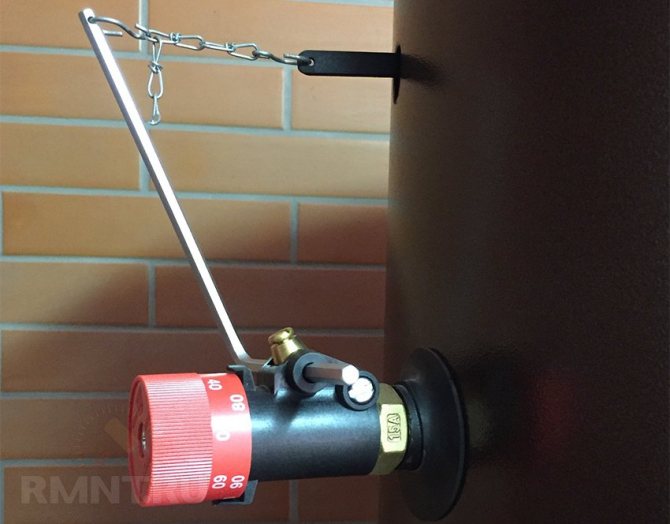

For solid fuel boilers, a number of protective devices of a different kind are provided, installed in the hydraulic piping. Of the absolutely obligatory ones, these are a circulation pump and protection of the furnace against overheating - a safety group for relieving excess pressure
Please note that the outlet of the relief valve must be facing the wall or fitted with a hose to avoid injury to persons present when triggered. Safety requirements can provide for the installation of a chimney undercut valve to stabilize draft and combustion, it is mounted immediately at the outlet of the boiler or directly in front of the final vertical section
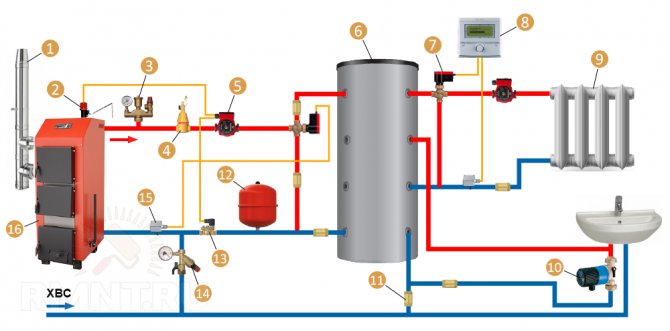

Connection diagram for a solid fuel boiler with a heat accumulator: 1 - chimney; 2 - thermostat; 3 - security group; 4 - air separator; 5 - circulation pump; 6 - heat accumulator; 7 - three-way mixer; 8 - weather-dependent automation; 9 - heating radiator; 10 - circulation pump; 11 - check valve; 12 - expansion tank; 13 - protection against dry running; 14 - make-up valve; 15 - laid-on temperature sensor; 16 - solid fuel boiler
For cast iron boilers, it is practiced to install a two-way valve that mixes water from the hot outlet to prevent cold water from entering the heated firebox. When installing a heat accumulator, a three-way electric valve is added, which starts the supply of heat to the tank only after the main composition has warmed up. The control is carried out according to the return temperature, the additional circuit is switched on 7-10 ºС before reaching the cut-off temperature. In this aspect, PID control units are most preferred.
